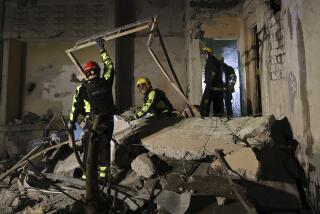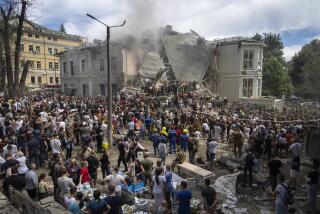Russia Strikes Chechnya With Fuel-Air Bombs
- Share via
MOSCOW — Seeking to block escape routes for guerrillas putting up fierce resistance in Grozny, the Russian military Monday reportedly targeted southern Chechnya with fuel-air bombs, highly destructive explosives capable of killing people sheltering in basements.
The military claimed that the bombs were used only against rebel bases in southern mountainous districts, but the Russian military has a record of bombing Chechen villages, exacting a high civilian toll, and later saying only rebel targets were hit.
Fuel-air bombs release a cloud of gas, which explodes and creates a lethal shock wave. The blast is capable of killing people in trenches, buildings or hidden deep in caves or bomb shelters.
Foreign military experts say the Russians used such weapons earlier this year against Chechen rebels who took shelter in caves after invading the neighboring Caucasus republic of Dagestan.
In the current battle for Chechnya, the Russians have surrounded the capital, Grozny, and are moving slowly against rebels defending it, while apparently using the fuel-air bombs to prevent them from reorganizing in the mountains.
The Interfax news agency quoted sources in Mozdok, the Russian military headquarters for Chechnya, as saying 550-pound and 1,100-pound fuel-air explosives were used. It did not say how many, or where exactly, they were dropped.
Western military experts said the use of fuel-air bombs was consistent with Russia’s conduct of the war.
Charles Blandy, a military expert at the Conflict Studies Research Center at Sandhurst Military Academy in Britain, said the chances of surviving an attack by such devices are slim.
“I would think if you are using it indiscriminately, you are going to hurt a lot of peaceful, innocent people,” he said. Blandy noted that Russian attacks in the Chechen war had been highly indiscriminate.
“There has been no care whatsoever throughout this campaign about how much damage is inflicted on the civilian population and infrastructure,” he said. “They 1/8the Russian military 3/8 just don’t care. They’ve got one objective, and that’s to get Chechnya back within the Russian Federation, and they don’t care how they do it.”
Christopher Foss, land forces editor of Jane’s Defense Weekly, said fuel-air explosives are not very accurate but could kill people over a large area.
“Fuel-air explosives create a massive over-pressure for which there is no practical defense,” he said. Foss said the injuries victims suffer in such an attack are likely to be “total.”
“Obviously, if fuel-air explosives are deployed in civilian areas, it would 1/8lead to high civilian casualties 3/8 because it’s an area weapon. It’s not a precision, pinpoint weapon.” Foss said such weapons are uncommon in Western armies.
U.S. Use of Devices Dates to Vietnam War
The United States is one country that has them.
Fuel-air explosives have been in the U.S. arsenal since the Vietnam War, and were also used by U.S. forces in the Persian Gulf conflict.
Unlike high-explosive bombs, which concentrate intense force on small areas, fuel-air explosives distribute a lesser but uniform force over a larger area to crush humans, vehicles and buildings.
In the U.S. arsenal, the 550-pound bomb, for example, emits an aerosol cloud that, when ignited by a detonator, flattens all nearby objects that are not reinforced and produces debilitating damage to objects many yards away.
By crushing buildings and sending debris flying, fuel-air explosives can kill dug-in enemy troops even if the aerosol cloud doesn’t penetrate their bunkers, experts say.
In Grozny on Monday, Russian forces and pro-Moscow Chechen volunteers continued their attack and faced fierce resistance from rebel fighters. The Russians launched a major assault Saturday to try to seize Grozny from an estimated 1,500 to 2,000 Chechen rebels. Tens of thousands of civilians are believed to be trapped in basements.
Russian Prime Minister Vladimir V. Putin said the assault on Grozny was going according to plan.
The Chechen side claimed Monday to have killed 300 Russian soldiers in the battle for Grozny, but Russian Defense Minister Gen. Igor D. Sergeyev said only four Russian troops died in the city Sunday.
There was also heavy fighting in southeastern Chechnya around Karachoi and Vedeno, strongholds of one of the leading rebel field commanders, Shamil Basayev.
It was Basayev and his rebels who invaded Dagestan in the summer, which led to the current war. Russian authorities also accused Basayev of masterminding several bombings of Russian apartments in the fall, another trigger for the war. Basayev is one of the key Russian targets in the war.
West Is Warned Against Sanctions
Russia has come under intense Western pressure to halt the bombing in Chechnya and to seek a political solution, but it has repeatedly brushed off Western offers to mediate.
Foreign Minister Igor S. Ivanov met with Russian President Boris N. Yeltsin on Monday and emerged warning the West not to threaten Russia with sanctions because of the Chechen war.
“We and the West are in constant contact on the political level, and that has not stopped,” Ivanov told reporters after the meeting. “Sometimes even allies have serious differences.”
Yeltsin plans to award medals today to top generals in the Chechen war--another rebuff to Western critics alarmed at the conduct of the war and the high civilian toll.
The commander in the Northern Caucasus, Col. Gen. Viktor Kazantsev, the commander of the eastern front in Chechnya, Lt. Gen. Gennady Troshev, and the commander of the western front in Chechnya, Maj. Gen. Vladimir Shamanov, will all be presented Hero of Russia stars--the highest state award.
Times staff writer Paul Richter in Washington contributed to this report.
More to Read
Sign up for Essential California
The most important California stories and recommendations in your inbox every morning.
You may occasionally receive promotional content from the Los Angeles Times.













